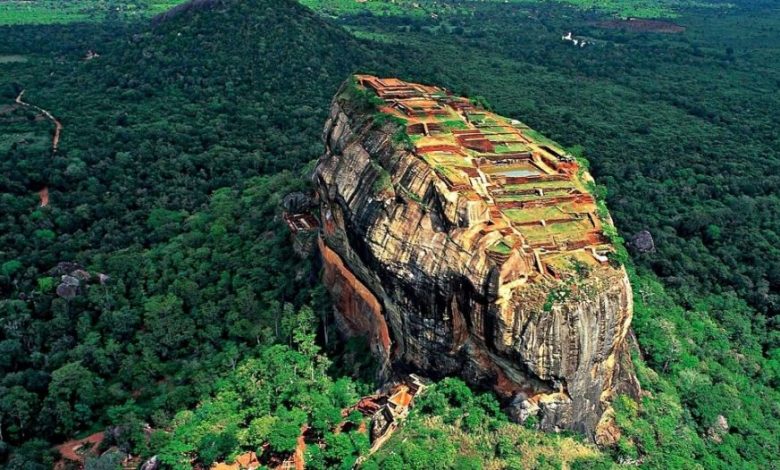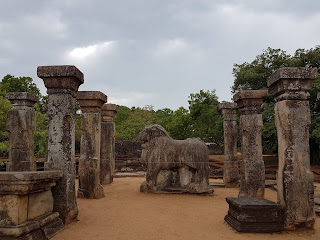There are totally 8 Unesco World Heritage Sites in Sri Lanka as of year 2020 (and 5 of them are actually located at The Cultural Triangle):
Cultural (6)
Natural (2)
If you are in a rush, but you still wish to visit all the world heritage sites in the cultural triangle, it is feasible to do that in 4 days 3 nights. How we did it (well, some of my friends, not me. I'm a lazy bum that skipped Anuradhapura) - charted a private van to bring us around with the following itinerary:
Day 0 - Travelling from Kuala Lumpur to Sri Lanka, reached Colombo Bandaranaike International Airport around 10pm, and stayed one night at Negombo
Day 1 - Woke up early, traveled from Negambo to Anuradhapura then to Dambulla, stayed 2 nights at Dambulla. More than 5 hours drive in total.
Day 2 - Day trip covering Sigiriya and Polonnaruwa. Stayed at Dambulla.
Day 3 - Visited Dambulla Royal Cave Temple and Golden Temple in the morning, then travelled from Dambulla to Kandy
Day 4 - Visited Kandy Temple of the Sacred Tooth Relic (participated in the puja session at 5:30am), and leave around noon to go to Nuwara Eliya.
Anuradhapura
The sacred city of Anuradhapura is a living heritage site and still a pilgrimage destination for Buddhists around the world as it was established around a branch of the Buddha’s fig tree. (the 'tree of enlightenment', brought there in the 3rd century B.C. by Sanghamitta, the founder of an order of Buddhist nuns.) I think this is the reason why some of my friends insisted to go to Anuradhapura, while those not so religious chose to stay at hotels and relaxed.
Anuradhapura was a capital city that flourished for more than 13 centuries, but was abandoned after an invasion, after which the capital was shifted to Polonnaruwa. This ancient capital city was hidden away in dense jungle for many years......
Ancient City of SigiriyaOur guide told us about the story of of King Kashyapa (
you can read this article from National Geographic). In the late fifth century, this Sinhalese prince killed his father and seized the throne, usurping his brother, who fled to India. Fearing reprisals, he built the fortress Sigiriya—but in vain: His brother returned, defeating Kashyapa, and Sigiriya lost its brief status as capital.
Even though briefly, still, this Ancient City of Sigiriya is one of the best examples of ancient urban planning. An integrated system of canals, lakes, and dams is extremely impressive and supply water to the lush gardens of the place. This put a lot of our Malaysia modern cities to shame.
For me, the most interesting part of the Ancient City of Sigiriya is the "Sky Palace" that sits atop of the 180m high Lion's Rock. The ruin of the palace is mysterious and the view is breathtaking. Almost like finally have the chance to visit the "Hanging Gardens of Babylon".
As the palace was inconveniently located at the top of the rock, they have to harvest rainwater and stored in large reservoirs and ponds on the summit. During the different seasons this pool neither overflows nor dries up.
We started our journey at 7:30am (the site opens at 8am) hoping that we could climb Sigiriya in a relatively cooling temperature. (Of course, not!)
 |
| The moat |
 |
| The Lion's Paws |
 |
| The "Sky Palace" at the summit |
 |
| Pidurangala in the background |
The climb of 1270 steps was not really hard, but having a 3 years old with us is a different challenge. (Luckily Yang is a brave and well-behaved kid. He had a few stops along the way, and he did complain a bit along the way, but he got a lot of cheers and encouragements from other tourists and he made it to the top with minimum help! His brother, Qian, 5 back then, also well-brought-up. Qian was the first one among us that reached the summit. On our way down, he told me he was exhausted when climbing his way up, "I almost wanted to give up but my mum always tell us that we have to persevere so I know I must get to the top". Such delightful.


Ancient City of Polonnaruwa
After meeting up with the other gang that went to the Pidurangala, we started our journey towards Polonnaruwa.
Polonnaruwa served as the capital city for nearly 2 centuries between the 11th and 13th centuries AD. It was a thriving commercial and religious centre, and the glories of that age can now be found in the archaeological park.
We arrived in a cloudy afternoon, with occasional sprinkle. We started our visit at the museum, to learn a little bit of the history before we explore the sites.
Royal Palace
Royal Palace is a massive structure, measuring 31 m by 13 m, once including 50 rooms supported by 30 columns. Archaeologists claim it once was seven floors tall with 3 m thick walls.
 |
| Royal Palace |
 |
| Audience Hall |
Sacred Quadrangle
My favorite part is the Sacred Quadrangle. It is a compact group of beautiful and impressive ruins within a raised up platform bounded by a wall. You walked in to the vicinity, and you could immediately "see" the flow of the river of time. Our guide even showed us the possible puja ritual flow that involved walking around all these different ruins.
 |
| Vatadage |
 |
| Atadage |
 |
| Gal Pota |
 |
| Thuparama |
Thuparama is one of the oldest, and one of the best preserved ancient buildings in Polonnaruwa. It is the only one with its roof intact, supported by corbel arch-style supports.
The inner chamber is delightfully cool and there are a number of Buddha statues standing in almost total darkness. The experience of just standing there, "seeing" people giving offerings, was magical. As if you accidentally went back in time, and "see" how it was done for centuries.
Buddha figures at Gal Vihara
Another must visit sites is the Gal Vihara. Gal Vihara is a group of four beautiful Buddhas in perfect condition, cut from one long slab of granite.
Other sites we visited at Polonnaruwa
 |
| Rankot Vihara |
 |
| Dagaba Kiri Vihara |
Dambulla Royal Cave Temple and Golden Temple
Dambulla Cave Temple complex consists of 5 caves covered from top to bottom in Buddhist mural paintings and more than 150 statues. The site, also known as the Golden Temple of Dambulla, is a living temple, which means that Buddhists from Sri Lanka and beyond travel to worship and pray at this complex.
 |
| View from Kandy Road |
We saw the giant golden buddha everyday when we passed by. We automatically assumed that this is the main entrance. So when we walked from Sundaras Resort & Spa to the Golden Temple of Dambulla via Kandy Road, we didn't even ask anyone. Little do we know that this is NOT the main entrance. We climbed the flights of stairs only to find out that the ticket counter is actually at the other part of the hill.
 |
| Sigiriya is clearly visible from here |
So a few of us had to walk to the other side of the hill, bought the entrance tickets for all of us, and climb a different flights of stairs to get back to the main entrance. So if you plan to go by your own, without a guide, make sure you ask about the ticketing before you start!
 |
| of course, must take photo with the Unesco World Heritage sign |
 |
| There are a lot of archaeological works inside the caves |

Kandy is located in hill country and features a large lake and lush mountain ranges. Kandy is most well known as the last capital of the Sri Lankan kings and for the golden-roofed Temple of the Sacred Tooth, home to Buddha’s Tooth that was brought to Sri Lanka in the 16th century.
 |
| again, Unesco World Heritage sign |
We arrived at Kandy in the evening. Jagath brought us straight to the city center before check in. Some of us did some prayers, then we explored area around the bodhi tree of the Dalada Maligawa, before we went back to Ceyloni Lake Residency for check in.
Ceyloni Lake Residency is conveniently located near the Kandy Lake. After check in and had some rest, we walked to Kandy city for dinner, and get familiar with the routes for tomorrow morning (to attend the 5:30am puja at the Temple of Tooth)
 |
| Group photo with Mr. Jagath |
The next morning, we bought our entrance ticket from the auto ticketing machine. Next, we left our shoes at the shoe room near the entrance (with a small fee) before going through the metal detectors. The whole process was quite smooth despite the long queue.
Because we were really early, we were lucky enough to get a very nice spot near the tooth casket. While waiting for them to open the heavily guarded room housing the tooth, we were surrounded by devotees. Sitting in this sacred atmosphere made one calm (including the 3 children). When the room finally open (you don’t actually see the tooth. It’s kept in a gold casket shaped stupa, which contains a series of six caskets of diminishing size), everyone slowly and orderly went near the door and prayed, or gave offerings. We were told that annually, during the Esala Perahera procession, the Relic casket gets paraded through the streets atop a male elephant; and in every 10 years, the inner most casket will be opened.


Because we have been telling the children that we're going to pray to the Buddha's tooth, and because one doesn't actually see the tooth, for our entire trip in Sri Lanka, Yang has been asking us "Where's the Buddha's tooth? When are we going to pray to the Buddha's tooth". I guess his parents have to bring him back here again when the casket is finally open. Haha!
Of course, the Temple of the Tooth is not only about the tooth, but in the complex there are also The Royal Palace, the Audience Hall and museums. You need to plan for about 2 hours for the visit.
While you are in Kandy, please don't forget to visit the beatiful city and hand around the Kandy Lake. While most people just using Kandy as the central stop for exploring the surrounding areas, it is actually quite a lovely place.
Other itineraries:
2017 - Germany: Upper Middle Rhine Valley One Day Tour (Stay tune)




























































No comments:
Post a Comment